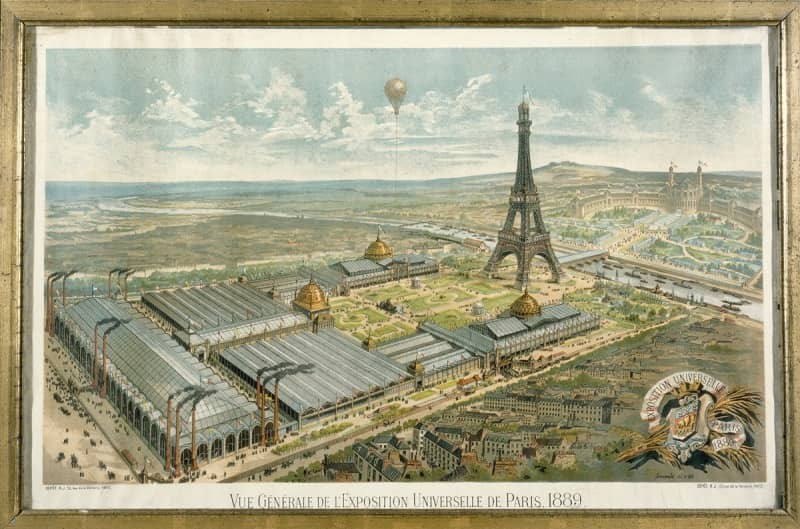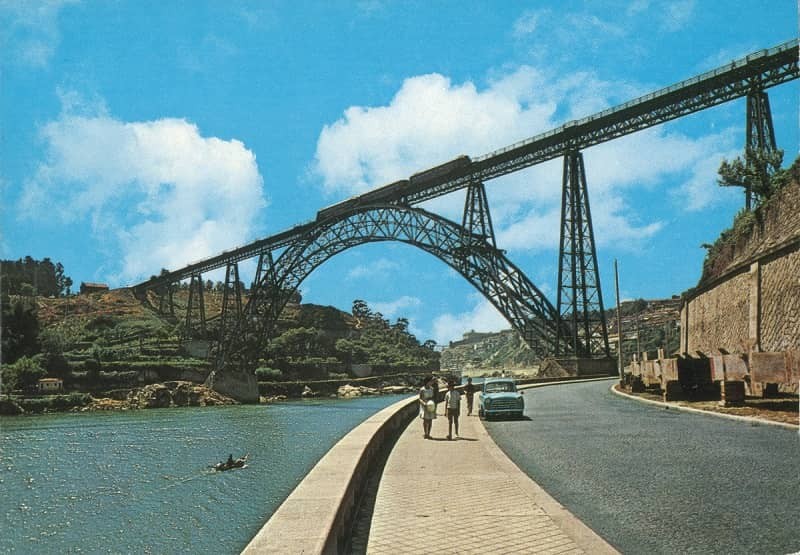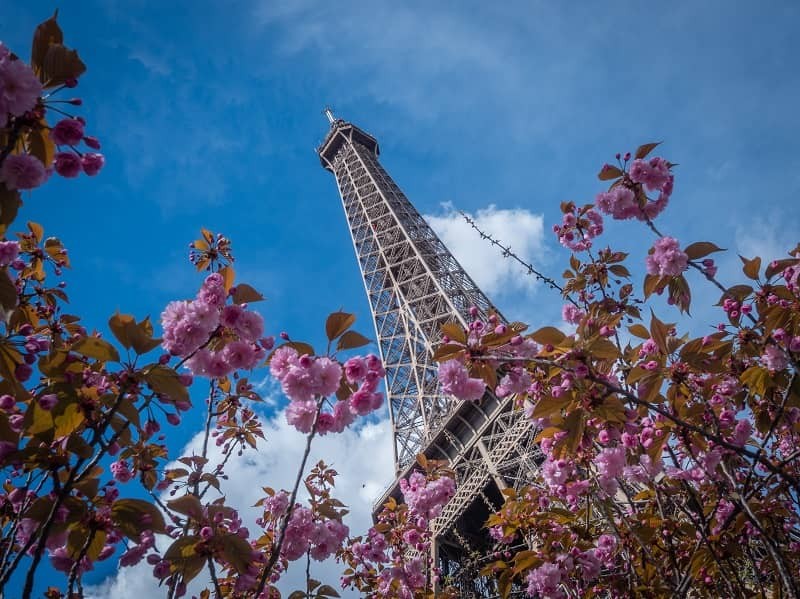Why was the Eiffel Tower built? The Eiffel Tower, a global icon, was constructed by Gustave Eiffel’s company between 1887 and 1889 as the centerpiece of the Paris World’s Fair, showcasing France’s industrial prowess. At WHY.EDU.VN, we delve into the tower’s construction, purpose, and enduring legacy, providing clear and reliable information. Discover the historical context, architectural marvel, and cultural significance of this iconic landmark, as well as its importance to French innovation and global recognition.
1. Who Was the Architect Behind the Eiffel Tower?
The Eiffel Tower was designed and built by Gustave Eiffel’s company from 1887 to 1889. Gustave Eiffel was a French engineer renowned for his expertise in metal frameworks and structures. His company was also responsible for other significant metallic works in Europe, showcasing his innovative engineering skills.
1.1 What Other Notable Projects Did Gustave Eiffel’s Company Undertake?
Besides the Eiffel Tower, Gustave Eiffel’s company was involved in several other noteworthy projects, including:
- Porto Viaduct (Portugal): A significant railway bridge demonstrating Eiffel’s expertise in metal construction.
- Viaduct du Garabit (France): Another impressive viaduct showcasing Eiffel’s ability to design and build large-scale metal structures.
- Budapest Train Station (Hungary): Eiffel’s company contributed to the construction of this major transportation hub.
- Statue of Liberty (New York, United States): Eiffel’s company built the metal framework for the Statue of Liberty, designed by Auguste Bartholdi. This monument was a gift from France to the United States, celebrating the 100th anniversary of American independence in 1886.
2. What Materials Were Used to Construct the Eiffel Tower?
The Eiffel Tower is made of puddle iron, not steel. This particular type of iron was sourced from the Pompey forges in eastern France, selected for its robust and reliable properties. The iron plates and beams were preassembled in Eiffel’s factories using rivets, allowing for efficient construction.
2.1 What is Puddle Iron and Why Was It Chosen?
Puddle iron is a refined type of iron produced through a puddling process, which removes excess carbon from the molten ore. This results in nearly pure iron, which Gustave Eiffel considered to be one of the best and most durable materials available at the time.
2.2 How is the Eiffel Tower Protected from Corrosion?
To protect the Eiffel Tower from corrosion, the iron structure is coated with a thick layer of paint that is renewed approximately every seven years. This repainting schedule, initially recommended by Gustave Eiffel himself, helps maintain the tower’s integrity and appearance.
3. What Was the Original Purpose of the Eiffel Tower?
The Eiffel Tower was built as one of the main attractions for the Paris World’s Fair in 1889. The World’s Fair showcased vast constructions in iron and steel, highlighting the industrial advancements of the time. The tower, initially called the 300-meter Tower, was intended to demonstrate France’s technological capabilities.
3.1 How Did the Public Initially React to the Eiffel Tower?
Despite initial controversy within the art world, the Eiffel Tower quickly captivated visitors and Parisians alike. Its unique design and impressive height made it an instant sensation, attracting over 2 million visitors in its first year.
4. Why is the Eiffel Tower So Famous?
The Eiffel Tower gained international fame immediately after its construction in 1889, primarily because it was the tallest building in the world at the time. Its distinctive silhouette was widely publicized, making it an instantly recognizable symbol of Paris and France.
4.1 What Did the Eiffel Tower Represent at the 1889 World’s Fair?
Gustave Eiffel’s masterpiece was intended to showcase France’s audacity in the industrial and technological domains during the centennial celebration of the French Revolution. The tower symbolized innovation, progress, and the nation’s forward-thinking spirit.
4.2 How Long Did the Eiffel Tower Hold the Title of World’s Tallest Building?
The Eiffel Tower remained the tallest building in the world for 40 years, until the completion of the Empire State Building in New York in 1931. This long tenure solidified its place in history as a groundbreaking architectural achievement.
4.3 How Many People Visit the Eiffel Tower Annually?
The Eiffel Tower attracts approximately 7 million visitors each year, making it one of the most visited monuments globally. Its enduring appeal continues to draw tourists from all over the world.
5. How Did the Eiffel Tower Become a Symbol of France?
The Eiffel Tower’s height and unique design quickly made it a prominent landmark in the Paris skyline. Its close association with Paris, the capital of France, naturally led to its adoption as a symbol of the entire country. The City of Paris owns the Eiffel Tower.
5.1 What Role Does the Eiffel Tower Play in National Events?
The Eiffel Tower serves as a focal point for numerous events in the life of Paris and France, including Bastille Day fireworks, national celebrations, and large-scale sporting events. Its presence enhances these occasions and reinforces its symbolic importance.
5.2 How is the Eiffel Tower Represented in Art and Culture?
The Eiffel Tower is frequently photographed, drawn, filmed, and replicated in various forms of media. It has become an iconic image in movies, graphic arts, literature, and poetry, symbolizing France in the collective imagination.
6. What Does the Eiffel Tower Represent to the French People?
For over 130 years, the Eiffel Tower has been a powerful symbol of Paris and France. Originally built for the 1889 World’s Fair, it impressed the world with its innovative design and symbolized French industrial genius.
6.1 How Does the Eiffel Tower Impact Daily Life in Paris?
Rising to a height of 330 meters, the Eiffel Tower is visible from many points in and around Paris. Its nightly illumination, including twinkling lights and a beacon that reaches 80 km, makes it a constant presence in the city’s landscape.
6.2 How Has the Eiffel Tower Been Involved in Historical Events?
The Eiffel Tower has witnessed and played a role in significant events in France’s history. It has also served as a laboratory for scientific experiments, notably in wireless telegraphy, which helped save it from demolition after its initial 20-year lifespan.
6.3 How Has the Eiffel Tower Adapted to Modern Technology?
The Eiffel Tower’s destiny is closely linked to advancements in radio and television. Today, it houses TDF installations and emitters that broadcast digital terrestrial television and radio channels to millions of residents in the Île-de-France region.
6.4 How is the Eiffel Tower Used to Express Solidarity?
In recent times, the Eiffel Tower’s lights have been turned off to honor victims of tragic events worldwide. This symbolic gesture has transformed the tower into a means of expression for the city of Paris and all of France.
7. Why is the Eiffel Tower Shaped Like the Letter “A”?
The shape of the Eiffel Tower is a result of engineering calculations and design considerations from 1884. Two engineers working for Gustave Eiffel envisioned a 300-meter-high metal tower for the 1889 World’s Fair.
7.1 What Engineering Principles Influenced the Eiffel Tower’s Design?
The engineers specialized in large-scale metallic structures like bridges, railway stations, and viaducts. The tower’s design, featuring four legs made of robust beams linked by open-web joists, reflects the principles used in constructing large viaducts.
7.2 How Does the Eiffel Tower’s Shape Relate to Other Structures Built by Eiffel?
The shapes and curves of the Eiffel Tower are reminiscent of the large viaducts built by Eiffel around the same time, demonstrating a consistent approach to structural engineering and design.
8. How Long Did It Take to Build the Eiffel Tower?
The Eiffel Tower was constructed in a remarkably short period: 2 years, 2 months, and 5 days, from late January 1887 to March 31, 1889. This rapid construction was an unparalleled achievement at the time, showcasing both technical and architectural prowess.
8.1 What Factors Contributed to the Eiffel Tower’s Rapid Construction?
The use of prefabricated components and efficient assembly techniques allowed for the swift completion of the Eiffel Tower. This innovative approach to construction demonstrated advanced engineering capabilities.
9. Is it Legal to Take Pictures of the Eiffel Tower at Night?
Private individuals are allowed to take pictures of the Eiffel Tower at night for personal use or social media sharing. However, professional use of nighttime images of the tower requires authorization from SETE (Société d’Exploitation de la tour Eiffel) due to copyright protections on the tower’s illuminations.
9.1 Why Are There Copyright Restrictions on Nighttime Images?
The Eiffel Tower’s various illuminations, including golden lights, sparkles, and special event displays, are protected by copyright. This means that commercial use of these images requires permission and may involve payment of usage rights.
10. Is the Eiffel Tower Considered a Work of Art?
Initially, the Eiffel Tower was not widely regarded as a work of art, as it was primarily seen as an engineering project. However, its unique design and cultural significance have gradually led to its recognition as an artistic achievement.
10.1 How Was the Eiffel Tower Selected for the 1889 World’s Fair?
In 1886, a competition was held to select a design for a tower to be built for the 1889 World’s Fair. Gustave Eiffel’s project, designed by engineers Maurice Koechlin and Emile Nouguier, and architect Stephen Sauvestre, was chosen from 107 other submissions.
10.2 What Role Did Engineers and Architects Play in the Eiffel Tower’s Design?
The collaborative effort of engineers and architects was crucial in creating the Eiffel Tower’s design. Their combined expertise ensured that the tower was both structurally sound and aesthetically pleasing.
11. Were There Any Fatalities During the Eiffel Tower’s Construction?
There were no serious injuries or deaths reported during the construction of the Eiffel Tower. This remarkable safety record is a testament to the careful planning and execution of the project.
12. What Does the Name “Eiffel Tower” Mean?
The Eiffel Tower is named after its creator, Gustave Eiffel, a 19th-century French entrepreneur and engineer. Eiffel specialized in building large-scale metal structures, including bridges, train stations, and viaducts.
13. How Many Levels Does the Eiffel Tower Have?
The Eiffel Tower has three levels open to the public: the first level, the second level, and the top. The second floor and the summit each have two levels, including enclosed and open-air areas. Visitors can reach the first two levels by stairs or elevator, while access to the summit is only available by elevator.
14. How Much Does the Eiffel Tower Weigh?
The Eiffel Tower weighs approximately 10,100 tons. The metal framework accounts for 7,300 tons, while the paint used to protect the structure weighs 60 tons.
15. Eiffel Tower FAQs
| Question | Answer |
|---|---|
| What is the height of the Eiffel Tower? | The Eiffel Tower stands at a height of 330 meters (1,083 feet). |
| How many steps are there to the top of the Eiffel Tower? | There are 1,665 steps to the top of the Eiffel Tower, but visitors can only climb to the second level. |
| How often is the Eiffel Tower repainted? | The Eiffel Tower is repainted approximately every seven years to protect it from corrosion. |
| What type of paint is used on the Eiffel Tower? | A special three-layer paint is used to protect the Eiffel Tower from rust and corrosion. |
| How much does it cost to visit the Eiffel Tower? | Ticket prices vary depending on the level you wish to visit and whether you take the stairs or the elevator. |
| Is the Eiffel Tower lit up every night? | Yes, the Eiffel Tower is lit up every night. The lights stay on until 1 AM. |
| Can you eat at the Eiffel Tower? | Yes, there are several restaurants located in the Eiffel Tower, offering different dining experiences. |
| Is the Eiffel Tower open year-round? | The Eiffel Tower is generally open year-round, but it may close temporarily due to weather conditions or special events. |
| How many light bulbs are used to illuminate the Eiffel Tower? | Approximately 20,000 light bulbs are used to illuminate the Eiffel Tower. |
| Has anyone ever lived in the Eiffel Tower? | Gustave Eiffel had a small apartment at the top of the tower, which he used for scientific observations and entertaining guests. |



Navigating the complexities of historical landmarks and architectural achievements can be challenging. Finding accurate and reliable answers to your questions requires credible sources and expert insights. At WHY.EDU.VN, we understand the need for trustworthy information and provide in-depth explanations on a wide range of topics.
Are you curious to learn more about the Eiffel Tower or other fascinating subjects? Visit WHY.EDU.VN today to explore our extensive collection of articles and expert answers. Our platform is designed to provide you with the knowledge you seek, offering clear, concise, and reliable information.
Do you have a specific question that needs answering? Don’t hesitate to reach out to our team of experts at WHY.EDU.VN. Contact us at 101 Curiosity Lane, Answer Town, CA 90210, United States, or via WhatsApp at +1 (213) 555-0101. You can also visit our website at why.edu.vn to submit your questions and receive personalized assistance. Let us help you uncover the answers you’re looking for.
